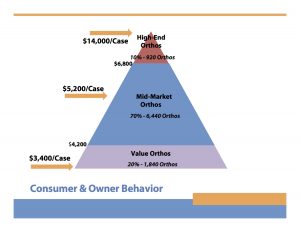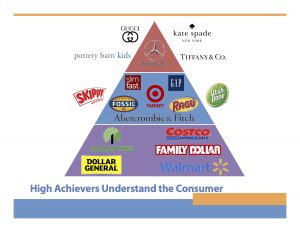As we discussed before, we orthodontists are perfectionists. We truly believe (falsely believe) that if we don’t deliver what we consider a “perfect” result to each and every patient that we are committing malpractice and are likely going to a bad place when we die. I’m here to tell you that while this mindset may seem admirable, it will likely be the death of our profession. Most people, the VAST majority, want straightER teeth. What does straighter mean? That depends on the individual of course but all the orthodontists I know use the .01% super picky outliers as their measuring stick for all patients and that is a huge mistake.
Yes, I want to get the best possible esthetic result for each and every patient I treat.
Of course, I want to achieve the best possible functional bite for each and every patient I treat.
But just like real doctors who want their patients to lose weight and exercise, we are limited by what the patient is willing to do in terms of time and effort and compliance and money. We cannot, well we should not, force patients to accept what we want for them and we darn sure shouldn’t do so if that means a case will go well beyond estimated treatment time. In this vein we should not even consider the super picky outliers when we are making decisions about our practice or setting policy. Outliers are, by definition, freaks that we cannot plan for and they should not come into play when making a business plan.
Now, on to the point.
Imagine there is an airline that has nothing but first class seats in all their planes but they only charge coach prices. In order to “do things properly” and “treat the customer right” this airline severely limits the number of clients it can transport while greatly increasing the expectations of customers by training them to demand first class service at a coach fare. How long do you think this airline will stay in business? It’s a silly question right? But it’s what we do…
Think about your practice – specifically phase I cases. In the most practices I see phase I cases that go on for years because the orthodontists bond permanent teeth as they erupt in an effort to make mom happy and treat the case “properly”. Mom only paid for early treatment to fix a specific problem but the orthodontist delivers comprehensive treatment over a longer than necessary time table and at a 50% discount in order to deliver good service and not upset mom. And what is the result of this gracious act? You guessed it. Mom and the patient are unhappy that they were in braces 4 years (and they should be).
Now think about a practice that has all the latest technology, provides gizmos to accelerate treatment, uses robots to bend the wire for them, does indirect bonding for patient comfort, speed and accuracy and spares no expense when it comes to the brackets and wires they use… All while charging the median price for braces in their area or darn close. This is a VERY common scenario but what does this have to do with first class airlines? Everything.
We orthodontists are virtually incapable of modulating our services to fit the fees we charge (or changing our fees to fit our services). To do so requires two things – 1) Self-awareness and 2) guts. Think about it. I hear orthodontists – almost all orthodontists – constantly talking about how much better their treatment and service and culture and everything is than the corporate practices and the PCDs who do braces but these same doctors charge a price that is all but indistinguishable from their “inferior” competitors and worry incessantly about what others are charging and get upset when someone is charging less than them. Does that make sense? What is going on here? Well, the orthodontists who act like this should MUST make a choice:
- Have the courage of their conviction and raise their fees substantially – like several thousand dollars – because Macy’s doesn’t try and compete with Dollar Store.
- Lower their fee and price match or undercut everyone else.
- Keep the same fee but modulate their services to be in line with their fee.
Instead most of us wallow in our indecision and insecurity while believing we are better than others and remaining unwilling to put this theory to the test. I did the same for a long time until last summer we radically changed our pricing to match the product and service we deliver. We are a large, multi-location, multi-doctor, multi-specialty practice that delivers solid results in a reasonable time frame without all the bells and whistles… and now our lower price reflects that reality. What happened when we changed? Our business is booming and because we modulate our service to match our price and now we can deliver orthodontic care affordably to more people than ever before while remaining profitable. I also know people who charge 10-20k per case and have a line of new patients out the door because they deliver first class service and results and their customers recognize that.
Look, it doesn’t matter how you choose to practice or what you choose to charge but I would strongly suggest you take a very hard look at how you choose to practice and match your fees up with that model. Better still, figure out what fee you can charge to get consumer engagement and make your product very attractive in your area and modulate your service level to fit that price. The second option is much more difficult for us orthodontists but if you can understand what I’m suggesting and implement then you’ll be well situated for whatever comes your way in the future.
COMMENTARY FROM CHRIS BENTSON:
Part of what Ben is talking about is market segmentation. We think it’s crucial that practice owners decide where they compete in the market they draw from. You can be very successful in any one of the three segments (shown in chart below) but it is very difficult to compete successfully in all three: as Ben suggests there is a different consumer expectation and a different overhead structure for each segment. We would suggest that the higher up the market segmentation pyrimid you compete in, the higher your overhead. We generally see this to be true. The highest pain point today is in the mid-market as value practices move up-market to grow and high-end move down-market to grow; the mid-market is being squeezed and crying the loudest; unfortunately that’s where most of you live. The numbers of orthodontists and price points in each segment were our best guess.
As an example of market segmentation outside of orthodontics the chart below shows some well known brands. The high-end and value brands have over performed over the last decade while the mid-market brands have been severely squeezed.




indeed
Right on! We shouldn’t be squeamish when it comes to our fees! But still many of us are. Nice article.
Well said